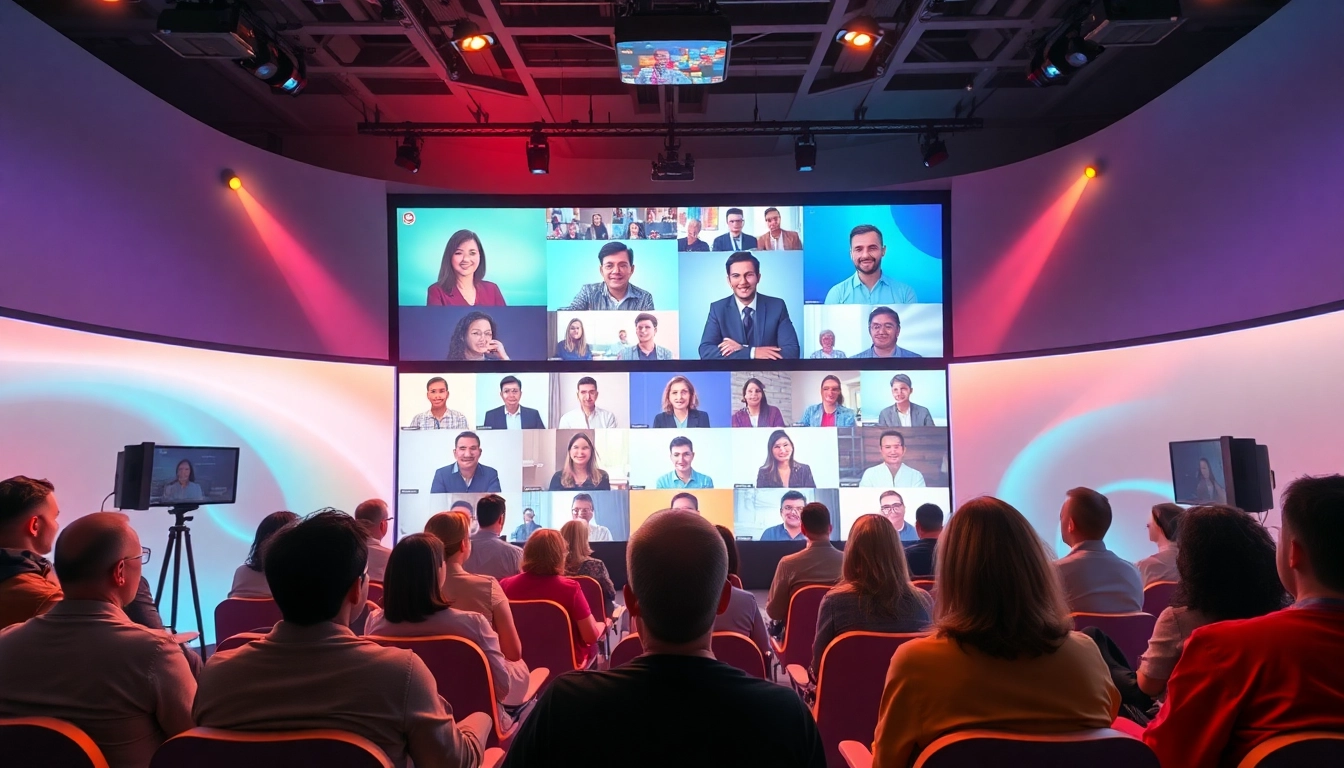Understanding the Virtual Audience System
The rise of digital technology has transformed the landscape of events and engagements, leading to the development of systems designed to interact with remote audiences effectively. One such innovation is the Virtual Audience System. This system allows hosts and presenters to connect, engage, and analyze their audiences in ways that were previously unimaginable, expanding the reach of live events to a global scale.
What is a Virtual Audience System?
A Virtual Audience System is an interactive platform that enables presenters to engage with audiences remotely through various digital channels. It encompasses tools and technologies that facilitate communications, audience participation, and real-time feedback and analytics during virtual events like webinars, conferences, and live streams. These systems vary in complexity and capability, providing a range of features from basic audience chat and polls to advanced tasks such as breakout rooms and immersive experiences using augmented reality.
Key Components of an Effective System
To maximize the efficacy of a Virtual Audience System, several key components must be integrated:
- Real-Time Engagement Tools: Features like live polling, Q&A sessions, and chat functionalities encourage audience interaction.
- Analytics Dashboard: Tools that track engagement metrics and participant feedback help refine future events.
- Video and Audio Quality: High-definition video and crisp audio ensure a professional presentation that resonates with users.
- Accessibility Options: Providing subtitles, sign language options, and screen reader compatibility to cater to all audience members.
- Integration Capabilities: Systems should seamlessly integrate with other tools such as CRM software, social media platforms, and marketing automation tools for enhanced user experience.
Benefits of Using a Virtual Audience System
Employing a Virtual Audience System offers numerous benefits:
- Increased Reach: Virtual events allow organizations to tap into a broader audience without geographical constraints.
- Cost Efficiency: Reduces expenses related to physical venues, catering, and travel, making events economically feasible.
- Data Insights: Advanced analytics provide insights into audience behavior and preferences, allowing for data-driven decision-making.
- Flexible Engagement: Participants can engage on their terms by choosing how and when to interact, leading to improved satisfaction and retention rates.
- Scalability: Easily adapts to accommodate different audience sizes, from intimate workshops to large conferences.
Implementing a Virtual Audience System
Steps to Set Up Your Virtual Audience
Setting up an effective Virtual Audience System involves several key steps:
- Define Your Objectives: Understand what you want to achieve during your virtual event, whether it’s education, marketing, or community engagement.
- Select the Right Platform: Choose a platform that aligns with your objectives and audience size. Consider usability, features, and integration capabilities.
- Plan Your Content: Develop engaging content and interactive elements to keep your audience interested throughout the event.
- Promote Your Event: Utilize email marketing, social media, and other channels to build awareness and draw in your audience.
- Perform Test Runs: Test all technology beforehand to ensure everything runs smoothly on the day of the event.
Choosing the Right Platform for Your Needs
Selecting the right platform is critical for the success of your virtual audience engagement. Consider the following when making your choice:
- Feature Set: Ensure the platform includes essential tools like video conferencing, chat functions, and polling options.
- User-Friendly Interface: A platform should be intuitive for both organizers and attendees to facilitate seamless interaction.
- Support and Training: Access to support and training materials to help you and your team navigate the platform effectively.
- Scalability: The platform should meet your current needs while allowing room for growth in audience size and event complexity.
Integrating Tools and Features for Success
To ensure successful implementation, it’s important to integrate various tools that enhance the audience experience:
- CRM Integration: Connecting your system with customer relationship management tools for a cohesive experience.
- Social Media Sharing: Allow easy sharing of the event on platforms like Facebook, Twitter, and LinkedIn for wider reach.
- Follow-Up Tools: Use automated follow-up emails or messages to keep the engagement going post-event.
- Feedback Collection: Implement feedback surveys to gather participant insights for future events.
Maximizing Engagement in Virtual Events
Interactive Features to Enhance Participation
Incorporating interactive features is key to maximizing audience engagement during virtual events. Consider these components:
- Live Q&A Sessions: Allow audience members to ask questions in real-time, facilitating conversation and immediate feedback.
- Polls and Surveys: Use these tools to gather opinions and encourage participation, keeping the audience involved.
- Breakout Rooms: Implement small group discussions to foster deeper interactions among participants.
- Gamification: Introduce elements like quizzes and competitions to make the experience enjoyable and memorable.
Strategies for Keeping Your Audience Engaged
Engagement does not stop with interactive tools; it requires strategic planning and execution. Here are some proven strategies:
- Utilize Storytelling: Captivating stories resonate well with audiences, holding their attention and making content more relatable.
- Encourage Networking: Provide opportunities for networking, allowing participants to connect with each other, thus enhancing the overall experience.
- Vary Presentation Styles: Mix formats—use videos, panels, live demonstrations, and discussions to keep the content fresh and engaging.
- Incorporate Breaks: Schedule short breaks to prevent digital fatigue and give attendees a chance to process information.
Analyzing Engagement Metrics
To refine future events and improve audience engagement, it is crucial to analyze engagement metrics effectively. Key metrics to track include:
- Participant Retention Rate: Measure how many participants stay for the duration of the event compared to the initial sign-ups.
- Interaction Levels: Analyze the frequency of audience engagement with features such as polls, Q&A sessions, and chats.
- Feedback Scores: Gather and evaluate participant feedback on content quality and overall experience.
- Conversion Rates: For marketing-focused events, assess how well attendees are turning into leads or customers.
Case Studies: Successful Virtual Audience System Deployments
Event Examples that Thrived with Virtual Engagement
Numerous organizations have successfully employed Virtual Audience Systems to engage with their audience. Here are notable examples:
- Tech Conference 2022: A multinational tech firm leveraged a Virtual Audience System for their annual conference, increasing attendance by 300% compared to previous in-person events. They utilized interactive features like polls and networking lounges to enhance engagement.
- Healthcare Webinar Series: A healthcare organization conducted a series of webinars covering various health topics, drawing hundreds of participants each week. By implementing follow-up surveys, they gained valuable insights which informed subsequent events.
- University Open Day: A university hosted a virtual open day with live tours, Q&A sessions, and student panels, resulting in a record number of inquiries and applications for the following academic year.
Lessons Learned from Industry Leaders
Through these successful deployments, several lessons can be gleaned:
- Emphasize Audience Engagement: Engaging tools and methods lead to higher participation rates and better feedback.
- Invest in Technology: High-quality technology ensures stability and professionalism during events.
- Prioritize Data Collection: Utilize metrics to inform future events; iterating based on audience feedback is crucial.
Comparative Analysis of Results
A comparative analysis of the success before and after implementing a Virtual Audience System reveals striking improvements:
- Event participation increased by an average of 250%.
- Audience engagement metrics, such as interaction rates and content feedback, rose significantly, with average scores moving from 60% to 85% satisfaction.
- Conversion rates for webinars transitioned from 5% to over 20% thanks to improved follow-up practices and engagement techniques.
Future Trends in Virtual Audience Systems
Emerging Technologies Shaping Virtual Interaction
The future of virtual events lies in innovative technologies that enhance audience interaction. Some notable trends include:
- AI and Personalization: Businesses will use artificial intelligence to offer personalized experiences, including tailored content delivery based on user behavior.
- Virtual Reality (VR) and Augmented Reality (AR): These technologies are poised to create immersive experiences that physically engage audiences.
- 5G Connectivity: With faster Internet speeds, the quality of virtual events will significantly improve, enabling higher resolutions and less latency.
Anticipating Changes in Audience Expectations
As virtual technology evolves, so too do audience expectations. Some anticipated shifts include:
- Seamless Integration: Audiences will expect seamless transitions between different formats and technologies during events.
- Increased Interactivity: Attendees will demand more interactive elements, such as real-time feedback and personalized content.
- Focus on Value: Beyond entertainment, audiences will seek substantive value from every virtual engagement, expecting actionable takeaways.
Preparing for the Future of Virtual Engagement
Organizations can prepare for future engagement by:
- Investing in Training: Educating staff on the use of new technologies and engagement methods will empower successful implementations.
- Exploring New Technologies: Keep abreast of emerging tech trends that can elevate the virtual experience.
- Engaging with Audience Feedback: Ongoing engagement with participants will provide insights into their evolving needs and preferences, ensuring future events remain relevant and impactful.


